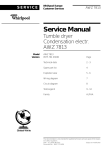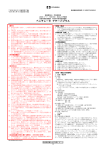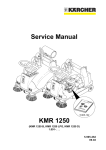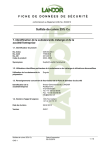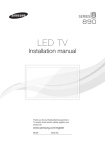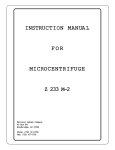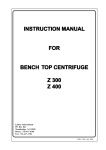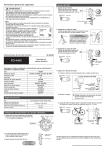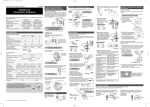Download Operating Instructions Series R44LS Discharge Bars
Transcript
F00022y Operating Instructions Series R44LS Discharge Bars for AC Voltage Operation BA-e-2003-0302 2 BA-e-2003-0302_R44LS List of contents 1 Outline of Series R44LS discharge bar for AC voltage operation 4 2 2.1 2.2 2.3 2.4 2.5 Safety . . . . . . . . . . . . . . . . . . . . . . . . . . . . . . . . . . . . . . . . . . . . . . . 7 Proper use . . . . . . . . . . . . . . . . . . . . . . . . . . . . . . . . . . . . . . . . . . . . 7 Identification of risks and hazards . . . . . . . . . . . . . . . . . . . . . . . . . . 7 Work and operational safety . . . . . . . . . . . . . . . . . . . . . . . . . . . . . . 8 Contact protection . . . . . . . . . . . . . . . . . . . . . . . . . . . . . . . . . . . . . . 9 Technical advance . . . . . . . . . . . . . . . . . . . . . . . . . . . . . . . . . . . . . . 9 3 3.1 3.2 3.3 3.4 3.5 3.6 Installations and assembly . . . . . . . . . . . . . . . . . . . . . . . . . . . . . 10 Length of the high voltage cable . . . . . . . . . . . . . . . . . . . . . . . . . . 10 Assembly of the discharge bar . . . . . . . . . . . . . . . . . . . . . . . . . . . 10 Distance between discharge bar and material surface . . . . . . . . . 12 Impact of temperature radiation . . . . . . . . . . . . . . . . . . . . . . . . . . . 12 Connecting oil and waterfree compressed air supply . . . . . . . . . . 13 Position of the air connections . . . . . . . . . . . . . . . . . . . . . . . . . . . . 14 4 Operation . . . . . . . . . . . . . . . . . . . . . . . . . . . . . . . . . . . . . . . . . . . 15 4.1 Selecting the operating voltage . . . . . . . . . . . . . . . . . . . . . . . . . . . 15 4.2 Function control . . . . . . . . . . . . . . . . . . . . . . . . . . . . . . . . . . . . . . . 15 BA-e-2003-0302_R44LS 5 Maintenance . . . . . . . . . . . . . . . . . . . . . . . . . . . . . . . . . . . . . . . . . 16 6 Troubleshooting . . . . . . . . . . . . . . . . . . . . . . . . . . . . . . . . . . . . . 17 7 Warranty . . . . . . . . . . . . . . . . . . . . . . . . . . . . . . . . . . . . . . . . . . . . 18 8 Technical specifications R44LS . . . . . . . . . . . . . . . . . . . . . . . . . 19 9 Dimensions . . . . . . . . . . . . . . . . . . . . . . . . . . . . . . . . . . . . . . . . . 20 10 Spare parts and accessories . . . . . . . . . . . . . . . . . . . . . . . . . . . 21 3 1. Outline of Series R44LS discharge bar for AC voltage operation 60 M8 15 16 = 35 M8 AL = Fig. 1: Series R44LS discharge bar GL EL L M8 15 5 1 7,535 E 5 241 R60 15 8 L E EL AL GL = = = = = Z00192y 85 Airchannel Electrode Installation length Active length Total length single-row discharge bar, air knife with air circulation of gas discharge, emission tip spacing: 15 mm, active lengths: 15…1995 mm in increments of 15 mm 4 BA-e-2003-0302_R44LS BA-e-2003-0302_R44LS 5 Dear customer, The Series R44LS discharge bars have been designed for the active removal of disruptive static charges during production processes. The bars are operated with an alternating voltage of 4.8…5.5 kV at 50…60 Hz and are suitable for eliminating static charges on surfaces with medium to high speeds. Due to the differences in the surface charge profiles of the various materials, charges of both polarities are supplied by the discharge bars. The geometric configuration of the corona segment guarantees an ultimate discharge effect. The R44LS discharging bars operate with air support and generate an adequate discharging effect even at larger distance. They improve the sheet separation from the pile to the copy stream, hold the copy stream in place at the 90° deviation station and help to improve pile formation. The air flow ventilation on the inside of the bar allows the unit to be used under high ambient temperatures of max. 80° with thermal screening and blast air. The optimum discharging effect is achieved in combination with Eltex high voltage supply units with 5 kV AC output voltage. 6 BA-e-2003-0302_R44LS 2. Safety The Series R44LS discharge bars have been designed, built and tested using state-of-the-art engineering, and they have left the factory in a technically and operationally safe condition. If used improperly, the bars may nevertheless be hazardous to personnel and may cause injury or damage. Read the operating instructions carefully and observe the safety instructions. Warning! Do not touch the emission tips of the discharge bar if the supply voltage of the power supply is switched on. Before cleaning or servicing the bar, always disconnect the bar from the supply voltage of the power supply unit. The manufacturers will not assume any liability and warranty if the bar is used improperly or used outside the intended purpose. 2.1 Proper use The Series R44LS discharge bars may only be used for eliminating static charges on material surfaces. Other uses are not permitted. The R44LS discharge bars must be operated only in connection with the dedicated Eltex high voltage supply units with 5 kV AC output voltage. This will ensure the proper adaptation to the required operating specifications of the various active bar lengths. Safe operation of the electrode bars is guaranteed only when using the Eltex high voltage supply units with 5 kV AC output voltage. Modifications and changes to the discharge bars are not permitted. Use only original Eltex spare parts and accessories. 2.2 Identification of risks and hazards Possible risks and hazards resulting from the use of the discharging bars are referred to in these operating instructions by the following symbols: Warning! This symbol appearing in the operating instructions refers to operations which, if carried out improperly, may result in serious personal injuries. BA-e-2003-0302_R44LS 7 Caution! This symbol appearing in the operating instructions refers to operations which, if carried out improperly, may result in damage to property. 2.3 Work and operational safety Warning! Carefully observe the following notes! • Check the discharge bars and the high voltage cables at regular intervals for any damage. Any damaged components must be repaired or replaced before continuing to operate the bar, or the appropriate bar or cable must be disabled. Make sure that the electrode bars are clean at all times. • Before carrying out repairs, cleaning or maintenance work, switch off the power supply unit and disconnect the supply voltage. • Do not touch the emission tips if the high voltage supply is connected. Reflex responses to electrical irritation may increase the risk of secondary accidents, especially in the vicinity of unguarded rotating assemblies. Persons with cardiac pacemakers are always at risk from high voltage and should take extreme care. • Mechanical or electrical modifications of the discharge bars are not permitted. Shortening the screened high voltage cable on the connecting side to the power supply unit is permissible. Lengthening the cable is only permitted via a suitable terminal box, an original high voltage cable and suitable cable glands. • The discharge bars must be repaired, serviced and tested by qualified personnel only. • The operation of the electrodes can generate ozone. The ozone concentration levels developing near the electrodes depend on many different factors such as site of installation, electrode stream and voltage, air circulation, etc., and can therefore not be specified in general terms. If the maximum allowable concentration (MAC) of ozone must be observed at the site of installation of the electrode, the concentration must be measured on site. 8 BA-e-2003-0302_R44LS 2.4 Contact protection As the installation site or eventual location of the discharge bars is outside the control of Eltex, a contact protection screen may have to be provided as specified in the regulations of the employers’ liability insurance associations (e.g. VBG 4 in Germany). 2.5 Technical advance The manufacturer reserves the right to make changes to the technical specifications without prior notice in order to adapt the units to state-ofthe- art engineering . Eltex will provide the latest information on any changes or modifications in the operating instructions on request. BA-e-2003-0302_R44LS 9 3. Installations and assembly 3.1 Length of the high voltage cable The high voltage cable is supplied in the following standard lengths: 2.5 / 5 / 7.5 and 10 meters, preassembled. Special lengths are available on request. The total length of the discharge bar and of the high voltage cable is limited as the transformer of the power supply unit is under capacitance load by the cable length. The maximum load capacity is therefore defined as a function of active bar length and the length of the high voltage cable. The relationship is shown in Fig. 2. Σ lengths of active bars [m] Fig. 2: Load capacity of the power supply units as factor of active bar length and length of the high voltage cable 15 12 10 ES50 ES31 15 7.5 permissible range 5 permissible range 5.0 20 30 40 50 Σ lengths of h.v. cable [m] ES51 permissible range 10 5 2.5 10 Σ lengths of active bars [m] 5 10 15 20 25 Σ lengths of h.v. cable [m] 10 20 30 40 50 Σ lengths of h.v. cable [m] Z00193e/Z00050e/Z00041e Σ lengths of active bars [m] 3.2 Assembly of the discharge bar The Series R44LS discharge bars must be connected to the machine via a metal bolted joint. For more convenient installation we recommend using the assembly and installation material supplied by Eltex (see Fig. 4). The assembly steps are shown in Fig. 3. Caution! The discharge bars must be grounded via the machine potential through the metal assembly brackets. The size M8 assembly bolts for attaching the discharge bar to the bracket must not exceed 12 mm in length. Longer bolts may damage the discharge bar. Discharge bars with a total length >1500 mm are equipped on the back with an M8 support plate; three M8 support plates are glued to bars with lengths >3000 mm. During installation the discharge bars must be supported with these support plates to prevent the bars from sagging. Failure to observe this mode of attachment may result in mechanical damage to the bars. Damage of this description is not covered by the warranty. 10 BA-e-2003-0302_R44LS Caution! Depending on site of use or location, the discharge bar must be protected against inadvertent contact by personnel. (Contact protection as specified in the regulations of the employers’ liability insurance associations. Please observe all national regulations according this item. The contact protection device should be made of insulating material such as GRP or similar material. Contact protection devices made of conductive material must be grounded 7 1 2 8 3 4 5 6 L E 1 2 3 4 5 6 7 8 BA-e-2003-0302_R44LS Airchannel Electrode Cylinder bolt DIN 912-M8x12-St Cylinder bolt DIN 84-M8x12-St Hexagonal nut DIN 933-M8x12-St Spring washer DIN 127-A8-St Washer DIN 125-A 8.4-St Attachment bracket R44 with 2 x longitudinal holes Max. torque 4 NM, secure with Loctite 243 Max. screw-in depth 4.5 mm 11 Z00194y E L Fig. 3: Assembly of the discharge bar with steel bracket Fig. 4: Attachment accessories 5 40 25 4 R5 60 9 3x45 40 25 4 R5 ˚ 40 25 60 R44MWS 5 9 3x45 ˚ 25 40 R44MWM 100 4 R5 120 25 5 9 40 R44MWL Z00195y 3x45 ˚ 16 R44MWS: Assembly bracket, small, with a total length of below 1500 mm R44MWM: Assembly bracket, medium, with a total length of below 1500 mm. R44MWL: Assembly bracket, large, with a total length of above 1500 mm 3.3 Distance between discharge bar and material surface The distance between the discharge bar and the material surface must be selected between 15 and 30 mm. Discharge bars with air support are used in cases where static charges impair the separation of piles to feed the copy stream or vice versa. The distance of the discharge bar from the edge of the pile is 5…20 mm in this application. The distance may be ≥20 mm in any other application. 3.4 Impact of temperature radiation The discharge bar must not be exposed to direct heat radiation which might lead to an excess of the maximum rated operating temperature of 80 °C. In the event of heat exposure caused by heated moulds and blowing tools, a temperature shield (e.g. a metal plate, approx. 3 mm thickness or a special plastic material) is required. The metal plate must not be allowed to rest on the discharge bar and must be grounded. Discharge bars with air support may also be operated with intermittent air blasts to prevent the tools from cooling down. The air blast is activated only, for instance, when the tool opens to discharge the moulding. 12 BA-e-2003-0302_R44LS 3.5 Connecting oil and waterfree compressed air supply The number of air connections depends on the length of the discharge bar (see Fig. 5). An internal hose diameter of 9 mm (NW 9) is required to connect the air hose to the air hose joint. The operating pressure must not exceed 3 bar and must be measured near the air distributor. The distributor crosssection must be dimensioned to match the number of hose connections or in compliance with the consumption volume. 3 4 5 2 6 3 4 2 5 1 6 0 7 bar 7 8 9 8 bar 1 Z00196y Fig. 5: Installation of the compressed air supply 1 2 3 4 5 6 7 8 9 Pressure gauge Pressure source NW 20 hose Throttle valve Rota flowmeter R44LS discharge bar NW 9 hose (e.g. 4 x 2.5 m) Distributor Manometer Fig. 5 shows the installation diagram for the air supply. The air distributor is not included with the delivery. Caution! If the discharge bar is fitted with several air connections, all hoses from the distributor to the connecting points must have the same length (identical pressure conditions). BA-e-2003-0302_R44LS 13 3.6 Position of the air connections 0 E L GL 5 ≤7 0 GL A C L E C GL A GL A [mm] [mm] GL ≤ 750 GL/2 750 < GL ≤ 1500 125…500 1500 < GL ≤ 2065 250…500 C [mm] Z00197y L E Fig. 6: Dimensions and position of the air connections as factor of total length GL 5 >7 Number of air connections 250 500 1 2 2 The air connections may also be led outside sideways. 14 BA-e-2003-0302_R44LS 4. Operation 4.1 Selecting the operating voltage ES50/ES51: Use the toggle switch to switch on the power supply. In the ON position the switch lights up green. High voltage is now supplied to the discharge bars. The output voltage is now a constant 5 kV AC. ES31: If the ES31 power supply is equipped with a potentiometer for setting the operating voltage (version ES31 VO and ES31 PO), adjust the potentiometer with the power supply switched on until the green signal lamp “Operating Voltage” lights up. The discharge bar will now be working with the optimum operating voltage of 5 kV at 50 Hz. 4.2 Function control ES50/ES51 In general, proper operation is indicated by the illuminated switch in all units. ES31 With the ES31 power supply switched on and the discharge bar connected, the signal lamp “Operating Voltage” (ES31 VO and ES31 PO only) on the power supply lights up. BA-e-2003-0302_R44LS 15 5. Maintenance Warning! Before carrying out any repair, maintenance or service work on the discharge bars and the power supply, switch off the power supply and disconnect the supply voltage. The machine on which the discharge bars are installed must not be in operation. Repair and maintenance work must be carried out by qualified personnel only. In order to ensure the proper function of the discharge bars, clean the bars at least once per week using compressed air free of oil and water (6 bar, standard compressed air pistol) and a non-metal brush. Dirt deposits such as grease, ink, glue, paper dust, etc. must be removed using a suitable solvent (e.g. cleaning gasoline). Do not soak discharge bars and high voltage cable in solvent! When cleaning the discharge bars, switch on the compressed air supply (1…2 bar) to prevent the air outlet nozzles from clogging up. Allow solvent to evaporate before resuming operations. Caution! Do not damage the emission tips of the discharge bars. 16 BA-e-2003-0302_R44LS 6. Troubleshooting Warning! Electric shock hazard! Before carrying out any repair, maintenance or service work, disconnect the supply voltage to the power supply. No high voltage must be applied on the discharge bars. Repair and maintenance work must be carried out by qualified personnel only. Fault Cause Remedy Effectiveness of application declines Dirt settled on bars Use compressed air and brush to clean bar. Dirt deposits such as grease, ink, oil etc. mast be removed using a suitable solvent (e.g. cleaning gasoline). Caution! Do not soak discharge bars in solvent! Allow solvent to evaporate before resuming operations. Operating Defective discharge If more than one discharge bar is voltage lamp bar. Check bar for connected to the power supply, fails to light up any defects which disconnect one after the other to may be caused by localize the defective bar. creep currents. Replace defective bar. Refer to the Power Supplies Operating Instructions for further malfunctions. BA-e-2003-0302_R44LS 17 7. Warranty The units are warranted for a period of 12 months provided that the operating conditions have been maintained, that the units have not been tempered with and that the units show no mechanical damage. The warranty applies only if the operating and assembly instructions specified by Eltex have been observed. The warranty period begins on the date of delivery. In the event of defects occurring during the warranty period, the units or defective components will be repaired at Eltex. Defective components will be replaced and installed free of charge. If repairs are required at the customer's premises, the costs for sending a technician (travel, travel time, expenses) will be charged to the customer. 18 BA-e-2003-0302_R44LS 8. Technical specifications R44LS BA-e-2003-0302_R44LS Electrode element fibre-glass-reinforced polyester GFK UL-94 V-0 Encapsulation compound epoxy resin with filler or PU with filler Assembly material steel brackets (see Fig. 4) Creepage resistance EN 50019 Grade A600 Disruptive strength 60 °C, EN 50028 DIN 53481 Specific volume resistance 60 °C DIN 53482, 3 x 1015 Ω x cm Flammability V-0 in compliance with UL 94 (1.6 mm) or ISO/R 1210 5...10 sec Operating ambient temperature 0...+80 °C (+32...+176° F) (only if blast is in operation, otherwise 0…+60 °C, (+32…+140 °F) Ambient humidity max. 70% relative, no dewing permissible Emission tips stainless steel, encapsulated and electrically isolated; low capacitance and non-sparking Dimensions see Fig. 7 Operating voltage 5 kV AC 50/60 Hz High voltage supply via Eltex power supplies with 5 kV AC output voltage Short-circuit current per tip approx. 0.055 mA Contact protection in compliance with EN 60335, Part 1 Air supply integrated air profile, air outlet apertures Ø 1mm, spacing 15 mm, air outlet apertures in special applications Ø 1.5 mm Air connections NW 9 mm hose, apparatus air free of oil and water, up to 40 meters in max. length (see Fig. 6) Air pressure max. 3 bar Air consumption 150…600 l/min per 1 meter of active bar length at 0.1...1 bar air pressure 19 9. Dimensions 60 M8 15 16 = 35 M8 AL = Fig. 7: Series R44LS discharge bar GL EL L M8 15 5 1 5 , 7 35 E 5 241 R60 15 8 L E EL AL GL = = = = = Z00192y 85 Airchannel Electrode Installation length Active length (15…1995 mm in increments of 15 mm) Total length 20 BA-e-2003-0302_R44LS 10. Spare parts and accessories BA-e-2003-0302_R44LS Article Article number Assembly bracket R44MWS Assembly bracket R44MWM Assembly bracket R44MWL MCH00011 MCH00002 MCH00009 21 Eltex offices and agencies Z01007y The addresses of all Eltex agencies can be found on our website at www.eltex.com Eltex-Elektrostatik-Gesellschaft mbH Blauenstraße 67, D-79576 Weil am Rhein Phone +49 (0) 76 21/ 79 05 - 0 Fax +49 (0) 76 21/ 79 05 - 310 eMail [email protected] Internet www.eltex.com






















